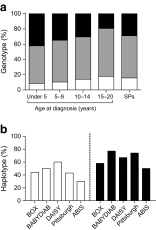Characteristics of slow progression to diabetes in multiple islet autoantibody-positive individuals from five longitudinal cohorts: the SNAIL study
- PMID: 29532109
- PMCID: PMC6449004
- DOI: 10.1007/s00125-018-4591-5
Characteristics of slow progression to diabetes in multiple islet autoantibody-positive individuals from five longitudinal cohorts: the SNAIL study
Abstract
Aims/hypothesis: Multiple islet autoimmunity increases risk of diabetes, but not all individuals positive for two or more islet autoantibodies progress to disease within a decade. Major islet autoantibodies recognise insulin (IAA), GAD (GADA), islet antigen-2 (IA-2A) and zinc transporter 8 (ZnT8A). Here we describe the baseline characteristics of a unique cohort of 'slow progressors' (n = 132) who were positive for multiple islet autoantibodies (IAA, GADA, IA-2A or ZnT8A) but did not progress to diabetes within 10 years.
Methods: Individuals were identified from five studies (BABYDIAB, Germany; Diabetes Autoimmunity Study in the Young [DAISY], USA; All Babies in Southeast Sweden [ABIS], Sweden; Bart's Oxford Family Study [BOX], UK and the Pittsburgh Family Study, USA). Multiple islet autoantibody characteristics were determined using harmonised assays where possible. HLA class II risk was compared between slow progressors and rapid progressors (n = 348 diagnosed <5 years old from BOX) using the χ2 test.
Results: In the first available samples with detectable multiple antibodies, the most frequent autoantibodies were GADA (92%), followed by ZnT8A (62%), IAA (59%) and IA-2A (41%). High risk HLA class II genotypes were less frequent in slow (28%) than rapid progressors (42%, p = 0.011), but only two slow progressors carried the protective HLA DQ6 allele.
Conclusion: No distinguishing characteristics of slow progressors at first detection of multiple antibodies have yet been identified. Continued investigation of these individuals may provide insights into slow progression that will inform future efforts to slow or prevent progression to clinical diabetes.
Keywords: HLA class II; Islet autoantibodies; Slow progression; Type 1 diabetes.
Conflict of interest statement
The authors declare that there is no duality of interest associated with this manuscript.
Figures


References
-
- Long AE, Gooneratne AT, Rokni S, Williams AJK, Bingley PJ. The role of autoantibodies to zinc transporter 8 in prediction of type 1 diabetes in relatives: lessons from the European Nicotinamide Diabetes Intervention Trial (ENDIT) cohort. J Clin Endocrinol Metab. 2012;97:632–627. doi: 10.1210/jc.2011-1952. - DOI - PubMed
-
- Steck AK, Johnson K, Barriga KJ, et al. Age of islet autoantibody appearance and mean levels of insulin, but not GAD or ,autoantibodies, predict age of diagnosis of type 1 diabetes: diabetes autoimmunity study in the young. Diabetes Care. 2011;34:1397–1399. doi: 10.2337/dc10-2088. - DOI - PMC - PubMed
Publication types
MeSH terms
Substances
Grants and funding
LinkOut - more resources
Full Text Sources
Other Literature Sources
Medical
Research Materials

